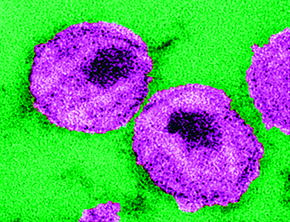
CDC / A. HARRISON; DR. P. FEORINOMolecular trigger: copies of HIV (pink), which unleash death through pyroptosisCDC / A. HARRISON; DR. P. FEORINO
Once inside the body, the human immunodeficiency virus (HIV) begins wiping out defense cells, especially the macrophages that should fight the virus. This massacre takes place indirectly and its effect is widespread. In two papers (Dec. 19, 2013, Science and Nature), a group led by Warner Greene, of the University of California, San Francisco (UCSF), described the biochemical pathways of cell death that are activated by HIV. Greene’s team has shown that once HIV penetrates cells, it sets off a sequence of chemical reactions that lead the cell to self-destruct through pyroptosis. Like apoptosis, which takes place inside of old, sick cells, pyroptosis is a form of cellular suicide. But while apoptosis is silent, pyroptosis is explosive: cells split open, unleashing inflammatory molecules. This finding opens a door for devising new ways of fighting the virus. Current therapies work by blocking the proteins made by HIV. Scientists believe it may be possible to develop compounds that target macrophage proteins and keep them from dying. In a test on cells, an experimental compound was shown to effectively halt the death of macrophages.
Republish